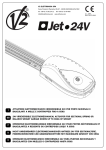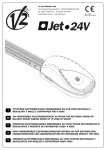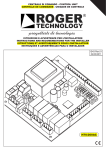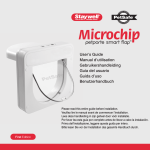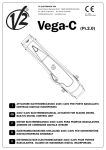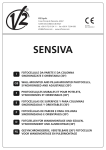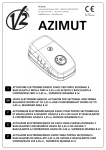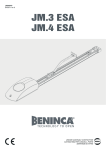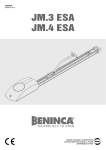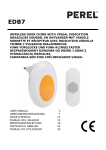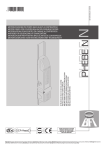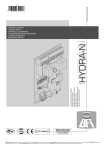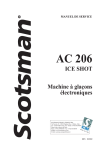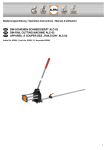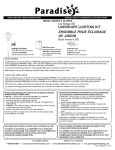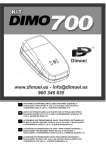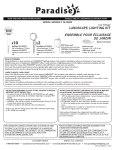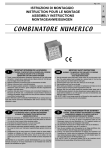Download KITJET650
Transcript
V2 ELETTRONICA SPA Corso Principi di Piemonte, 63 12035 RACCONIGI (CN) ITALY tel. +39 01 72 81 24 11 fax +39 01 72 84 050 info@v2elettronica.com www.v2elettronica.com COMPANY WITH QUALITY SYSTEM CERTIFIED BY QMSI UNI EN ISO9001 IL n. 158 EDIZ. 10/09/03 KITJET650 I KIT 24 VDC PER PORTE SEZIONALI E BASCULANTI A MOLLE E CONTRAPPESI FINO A 65 KG GB 24 VDC KIT FOR SECTIONAL SPRING OR BALANCE WEIGHT GARAGE DOORS UP TO 65 KG OF WEIGHT F KIT 24 VDC POUR PORTES SÉCTIONNELLES ET BASCULANTES A RESSORTS OU CONTREPOIDS JUSQU' À 65 KG D KIT 24 VDC FÜR UNTERTEILTE TORE, FEDERSCHWINGTORE UND GEGENGEWICHTTORE MIT MAXIMALEM GEWICHT VON 65 KG E KIT 24 VDC PARA PUERTAS SECCIONALES Y BASCULANTES CON MUELLES O CONTRAPESOS HASTA 65 KG 225 KITJET650 392 147 487 1 Fig. 1 Fig. 2 Fig. 3 Fig. 4 Fig. 5 Fig.6 2 Fig. 7 Fig. 8 Fig. 9 Fig. 10 Fig. 11 Fig. 12 3 Fig. 13 Fig. 14 Fig. 15 Fig. 16 P1 4 Fig.17 Fig.18 5 COLLEGAMENTI ALLA MORSETTIERA - TERMINAL CONNECTIONS - BRANCHEMENTS A LA BORNIERE ANSCHLÜSSE AM KLEMMENBRETT - CONEXION DE LOS BORNES 20 21 17 18 1819 19 L1 = 230V 40W F1 = 1A 15 16 13 14 STOP START 1 2 3 4 5 6 7 8 9 10 11 12 LINE 230VAC CMS VRD 24V 12V GND 1 2 3 GND 24V 1 2 3 4 5 6 12V 24V GND 3 2 1 DATA 1 2 RIF50-TX RIF50-RX 6 BLINKER 24V - 10W WA R N I N G LIGHT 24V - 3W 1. 2. Costa meccanica di sicurezza Mechanical safety rib Banda mecánica de (CMS) Comando di apertura per il Opening command to connect Commande de ouverture pour Ausschaltbefehl für den VRD- Comando de apertura para la collegamento di VRD (ingres- VRD (data input) seguridad (CMS) le branchement du VRD Anschluss (Dateneingang) (entrée données) conexión de VRD (entrada datos) Comando di apertura per il Opening command to connect Commande de ouverture pour Ausschaltbefehl für den Comando de apertura para la collegamento di dispositivi traditional devices having nor- le branchement des disposi- Anschluss traditioneller conexión de dispositivos tra- tradizionali con contatto nor- mally open contact Vorrichtungen mit NO-Kontakt dicionales con contacto nor- malmente aperto. 4. Sicherheitsvorrichtung (CMS) (CMS) so dati) 3. Barre palpeuse (CMS) tifs traditionnelsavec contact normalement ouvert. malmente abierto. Comando di Stop. Contatto Stop command. Normally clo- Commande Stop. Contact normalmente chiuso sed contact normalement fermé 5. - 8 - 11 Comune (-) Common (-) Commun (-) Allgemein (-) Común (-) 6. Fotocellula. Contatto normal- Photocell. Normally closed Cellule. Contact normale- Fotozelle. NC-Kontakt Fotocélula. Contacto normal- mente chiuso contact ment fermé Alimentazione +24VDC 10W +24VDC 10W photocell (RX) Alimentation +24VDC 10W Versorgung +24VDC 10W für Alimentación 24 Vdc 10W per fotocellule (RX) ed altri power supply and other pour cellules (RX) et autres Fotozelle (RX) und sonstiges para RX fotocélulas y otros accessori accessories accessoires Zubehör accesorios Lampeggiante +24VDC 10W +24VDC 10W blinker Clignotant +24VDC 10W Blinkleuchte +24VDC 10W Lámpara de señalización 7. 9. Stopp-Befehl. NC-Kontakt Comando de Stop. Contacto normalmente cerrado mente cerrado +24VDC 10W 10. Alimentazione obbligatoria TX TX +24VDC 1W photocell power Alimentation TX +24VDC 1W Versorgung TX +24VDC 1W Alimentación obligatoria TX +24VDC 1W fotocellule per 24 Vdc 1W fotocélulas para supply for the check test cellules pour Test fonctionnel Fotozelle für Funktionstest 12. Lampada spia +24VDC 3W +24VDC 3W Pilot light Lampe regard 24VDC 3W Signalleuchte +24VDC 3W 13. - 14. Alimentazione 230VAC 50Hz 230VAC 50Hz Power supply Alimentation 230VAC 50Hz Stromversorgung 230VAC 50Hz Alimentación 230 Vac 50 Hz 15. Centrale antenna Antenna gearbox Centrale antenne Zentrale Antenne Positivo antena 16. Calza antenna Antenna hearth brade Bas de antenne Umflechtung Antenne Malla antena 17. - 18. - ENCODER ENCODER ENCODER ENCODER ENCODER ROSSO - Uscita motore RED - 24VDC motor output Test funzionale Test de funcionamiento Lámpara piloto 24 Vdc 3W 19. 20. 24VDC ROUGE – Sortie moteur ROT – Ausgang Motor 24VDC ROJO - Salida motor 24 Vdc 24VDC 21. BLU - Uscita motore 24VDC BLUE- 24VDC motor output BLEU – Sortie moteur 24VDC BLAU – Ausgang Motor AZUL - Salida motor 24 Vdc L1 Luce di cortesia 230V, MAX 230V, MAX 40 W courtesy Lumiere de courtoisie 230V, Durchgangsleuchte 230V, Luz de cortesía 230V, MAX 40 W modello E14 lamp, model E14 MAX 40 W model E14 MAX 40 W Modell E14 40W modelo E14 24VDC 7 ITALIANO AVVERTENZE IMPORTANTI OPERAZIONI PRELIMINARI Per chiarimenti tecnici o problemi di installazione la V2 ELETTRONICA dispone di un servizio di assistenza clienti attivo durante le ore di ufficio TEL. (+39) 01 72 81 24 11 Prima di procedere con l’installazione è fondamentale verificare i seguenti punti: • la struttura della porta deve essere solida ed appropriata • la porta si deve aprire e chiudere liberamente senza nessun punto di attrito. • la porta deve essere adeguatamente bilanciata sia prima che dopo l'automatizzazione (eventualmente provvedere ad una regolazione dei contrappesi). V2 ELETTRONICA si riserva il diritto di apportare eventuali modifiche al prodotto senza preavviso; inoltre declina ogni responsabilità per danni a persone o cose dovuti ad un uso improprio o ad un’errata installazione. • • • 1 - MONTAGGIO Leggere attentamente il seguente manuale di istruzioni prima di procedere con l'installazione. 1.1 Assemblare il profilato guida utilizzando le apposite barre di giunzione bulloni e le rondelle (fig.1). Il presente manuale di istruzioni è destinato solamente a personale tecnico qualificato nel campo delle installazioni di automazioni. Nessuna delle informazioni contenute all'interno del manuale può essere interessante o utile per l'utilizzatore finale. Qualsiasi operazione di manutenzione o di programmazione deve essere eseguita esclusiavamente da personale qualificato. 1.2 Inserire il carrello di traino nel profilato guida (fig.2). ATTENZIONE: se si vuole installare il kit accessorio per lo sblocco dall'esterno J5 è necessario inserire il cordino metallico nell'apposito foro del carrello di traino (Fig. 16) prima di inserire il carrello nel profilato. 1.3 Montare i supporti di fissaggio : inserire i bulloni e le piastrine forate negli appositi vani del profilato, adattare i supporti sul profilato in corrispondenza dei bulloni e chiudere i dadi (fig.3). Nel caso in cui sia necessario adattare l'automazione in altezza utilizzare le apposite barre forate e la staffa (fig.4). L’AUTOMAZIONE DEVE ESSERE REALIZZATA IN CONFORMITÀ VIGENTI NORMATIVE EUROPEE: EN 60204–1 (Sicurezza del macchinario, equipaggiamento elettrico delle macchine, parte 1: regole generali). EN 12445 (Sicurezza nell'uso di chiusure automatizzate, metodi di prova). EN 12453 (Sicurezza nell'uso di chiusure automatizzate, requisiti). • • • • • • • , i 1.4 Inserire il cursore , la catena e le barre di sostegno attuatore appositi vani del profilato guida (fig.5). L'installatore deve provvedere all'installazione di un dispositivo (es. interruttore magnetotermico) che assicuri il sezionamento onnipolare del sistema dalla rete di alimentazione. La normativa richiede una separazione dei contatti di almeno 3 mm in ciascun polo (EN 60335-1). Per la connessione di tubi rigidi e flessibili o passacavi utilizzare raccordi conformi al grado di protezione IP55 o superiore. L’installazione richiede competenze in campo elettrico e meccanico; deve essere eseguita solamente da personale qualificato in grado di rilasciare la dichiarazione di conformità di tipo A sull’installazione completa (Direttiva macchine 98/37/EEC, allegato IIA). E’ obbligo attenersi alle seguenti norme per chiusure veicolari automatizzate: EN 12453, EN 12445, EN 12978 ed alle eventuali prescrizioni nazionali. Anche l’impianto elettrico a monte dell’automazione deve rispondere alle vigenti normative ed essere eseguito a regola d’arte. La regolazione della forza di spinta dell’anta deve essere misurata con apposito strumento e regolata in accordo ai valori massimi ammessi dalla normativa EN 12453. Consigliamo di utilizzare un pulsante di emergenza da installare nei pressi dell’automazione (collegato all’ingresso STOP della scheda di comando) in modo che sia possibile l’arresto immediato del cancello in caso di pericolo. 1.5 Portare il profilato guida 1.6 Chiudere i due bulloni negli a battuta sulla testa dell'attuatore (fig.5). con gli appositi dadi (fig.5). 1.7 Inserire nelle apposite guide del profilato la placchetta fissare leggermente con le due viti (fig.6,7). e la staffa , 1.8 Inserire il gruppo anteriore di fissaggio sul profilato guida e portare fino a battuta. Fissare il particolare alla staffa tramite l'apposita vite di regolazione (fig.7). 2 - INSTALLAZIONE 2.1 Smontare il sistema di chiusura della porta sostituendolo con lo sblocco a filo. 2.2 Misurare l'esatta metà della porta e tracciare dei punti di riferimento sulla traversa superiore e sul soffitto per facilitare il posizionamento del profilato guida . CONFORMITÁ ALLE NORMATIVE 2.2 Fissare il gruppo anteriore di fissaggio (fig.8) o sul soffitto (fig.9). V2 ELETTRONICA SPA dichiara che gli attuatori della serie JET650 sono conformi ai requisiti essenziali fissati dalle seguenti Direttive: 73/23/EEC sicurezza elettrica 93/68/EEC compatibilità elettromagnetica 99/05/EEC direttiva radio 98/37/EEC direttiva macchine alla traversa superiore della porta 2.4 Seguendo i riferimenti precedentemente tracciati sul soffitto individuare i punti di fissaggio per i supporti o la staffa , forare e utilizzando dei tasselli da muro ancorare l'automazione al soffitto (fig.10, 11). 2.5 Solo per porte sezionali e basculanti a molle Fissare la squadretta di traino sulla parte superiore della porta rispettando i riferimenti precedentemente tracciati. Unire la squadretta di traino e la barra forata tramite l'apposito braccio curvo utilizzando bulloni e dadi in dotazione (fig.12). Nota: Dichiara che non è consentito mettere in servizio i dispositivi sopra elencati fino a che la macchina (cancello automatizzato) sia stata identificata, marchiata CE e ne sia stata emessa la conformità alle condizioni della Direttiva 89/392/EEC e successive modifiche. Il responsabile della messa in servizio deve fornire i seguenti documenti: • Fascicolo tecnico • Dichiarazione di conformità • Marcatura CE • Verbale di collaudo • Registro della manutenzione • Manuale di istruzioni ed avvertenze 2.6 Solo per porte basculanti a contrappesi Fissare il braccio ad archetto sulla parte superiore della porta seguendo i riferimenti precedentemente tracciati. La parte inferiore deve essere fissata allo stesso livello della superiore, quindi se il punto di fissaggio non coincide con una traversa della porta inserire uno spessore (fig.13). Collegare la barra forata alla barra forata del braccio ad archetto utilizzando bulloni e dadi in dotazione. Racconigi il 10 / 09 / 2003 Rappresentante legale V2 ELETTRONICA SPA A. Livio Costamagna SBLOCCO DALL'INTERNO Per sbloccare l'automazione è sufficiente tirare il pomello verso il basso (fig 14). ATTENZIONE: non usare il pomello con cordino per aprire la porta. DATI TECNICI SBLOCCO DALL'ESTERNO Alimentazione 230VAC 50Hz Potenza motore 43 W Assorbimento da linea 1A Potenza assorbita 230 W Corrente max motore 6A Carico max accessori alimentati a 24 VAC 10 W Temperatura di lavoro -20 ÷ +50 °C Fusibili di protezione F1 = 1 A Grado di protezione IP20 Ciclo di lavoro 30 % Peso 10 Kg Per sbloccare l'automazione dall'esterno è necessario installare l'apposito kit accessorio di sblocco (cod. J5). • Inserire il cordino metallico nell'apposito foro del carrello di traino (Fig. 16) • Inserire la guaina sul cordino e montare i restanti elementi del kit come da fig. 17, 18. • Tendere il cordino e fissarlo tramite l'apposita vite di fissaggio in modo da consentire lo sblocco completo dell'autoamzione. Una volta installato il kit è sufficiente ruotare la maniglia della porta per sbloccare l'automazione; riportare la maniglia nella posizione iniziale prima di aprire la porta. RIPRISTINO DELL'AUTOMAZIONE Per ripristinare l'automazione procedere come segue: • • 8 Riportare la leva di sblocco nella posizione iniziale (fig 14). Azionare il motore con un semplice comando di START: il cursore aggancerà automaticamente il carrello di traino ripristinando l'automazione. FUNZIONE START DEL TASTO La centrale aziona un motore a spazzole a bassa tensione (24 Vdc), per l’automazione di porte sezionali e basculanti. Premere il tasto P1 presente sulla scheda per impartire un comando di start, la pressione deve durare meno di 5s onde evitare l’attivazione dell’apprendimento radio. Caratteristiche principali: • Alimentatore switching 140W • Uscite: 24Vdc per accessori lampeggiante 24Vdc (2 Hz) lampada spia 24Vdc(1 Hz in apertura, 2 Hz in chiusura) alimentazione TX fotocellula luce di cortesia 220V • • • • • • • • • • LOGICA DI FUNZIONAMENTO La logica di funzionamento dipende dalla programmazione durante la fase di autoapprendimento e dalla presenza della fotocellula. LOGICA PASSO PASSO Ingressi: START, STOP, FOTOCELLULA, DATI (VRD), COSTA DI SICUREZZA (CMS). Encoder incorporato. Ricevitore 433 MHz super-eterodina incorporato. Apprendimento radio a distanza, possibilità di memorizzare fino a 83 codici diversi. Tasto di autoapprendimento radio su scheda. Cancellazione totale dei codici in memoria. Test per rilevare la presenza della fotocellula: senza fotocellula funziona solo con logica PASSO-PASSO, con la fotocellula collegata funziona anche con logica automatica. Ciclo automatico di apprendimento: tempo di lavoro, livello di amperometrica, logica di funzionamento (passo-passo o automatica), durata del tempo di pausa Controllo amperometrico per evitare schiacciamenti. Rallentamento. La logica PASSO PASSO permette il funzionamento ciclico APRE - STOP - CHIUDE - STOP - APRE FOTOCELLULA in APERTURA: FOTOCELLULA in CHIUSURA: AMPEROMETRICA in APERTURA: AMPEROMETRICA in CHIUSURA: START in APERTURA: START in CHIUSURA: STOP in APERTURA: STOP in CHIUSURA: COSTA DI SICUREZZA in APERTURA: COSTA DI SICUREZZA in CHIUSURA: LOGICA AUTOMATICA COLLEGAMENTI ELETTRICI START in APERTURA: START in CHIUSURA: START in PAUSA: FOTOCELLULA in APERTURA: FOTOCELLULA in CHIUSURA: STOP in APERTURA: STOP in CHIUSURA: FOTOCELLULA in PAUSA: COSTA DI SICUREZZA in APERTURA: COSTA DI SICUREZZA in CHIUSURA: Leggere attentamente il paragrafo AVVERTENZE IMPORTANTI nella pagina precedente. • Aprire il carter facendo ruotare il pulsante P1 di 90° (Fig. 15) • Per i collegamenti seguire il paragrafo COLLEGAMENTI ALLA MORSETTIERA (pag. 6). • Terminati i collegamenti richiudere il carter e ruotare il pulsante nella posizione iniziale. APPRENDIMENTO AUTOMATICO Durante l’apprendimento automatico la centrale memorizza il livello di amperometrica, il tempo di apertura e chiusura, il tempo di pausa, la logica di funzionamento se la fotocellula è presente, le funzioni prelampeggio, e test della fotocellula. Se la fotocellula è collegata è possibile selezionare la logica di funzionamento in fase di apprendimento automatico (passo-passo o automatica), se non è collegata funzionerà solo con logica PASSO-PASSO. Procedere come segue: Premere e tener premuto il tasto P1 per 15s. 2 La luce di cortesia si accende e il motore si muove in chiusura fino ad incontrare il fine corsa o l’amperometrica, la luce di cortesia si spegne per 1,5s. 3 Test della fotocellula: se non è collegata salta al punto 5 con logica passo-passo. 4 La luce di cortesia si accende per 5s in attesa di una pressione del tasto P1: pressione entro i 5s: LOGICA AUTOMATICA nessuna pressione: LOGICA PASSO-PASSO 5 Il motore si muove in apertura per apprendere il livello di amperometrica e la coppia neccessari, al termine la luce di cortesia si spegne per 1,5s. 6 Se la logica selezionata è PASSO-PASSO salta al punto 7, altrimenti inizia l’apprendimento T.PAUSA: la luce di cortesia comincia a lampeggiare 1 volta al secondo (1 LAMPEGGIO = 10s), premere il tasto P1 quando è trascorso il tempo desiderato. 7 La luce di cortesia si accende e il motore si muove in chiusura per apprendere il livello di amperometrica e la coppia neccessari, al termine la luce di cortesia si spegne per 1,5s. 8 Se la fotocellula non è collegata salta al punto 9, altrimenti la luce di cortesia si accende per 5s in attesa di una pressione del tasto P1: pressione entro 5s: TEST FOTOCELLULA ATTIVATO nessuna pressione: TEST FOTOCELLULA DISATTIVATO 9 Il motore si muove nuovamente in apertura per apprendere il tempo di apertura, quando incontra l’amperometrica la luce di cortesia si spegne per 1,5s. NON SENTITO INVERTE CHIUDE NON SENTITO INVERTE FERMA FERMA RICARICA T.PAUSA FERMA INVERTE La centrale effettua un test per verificare la presenza della fotocellula ed il suo corretto funzionamento prima di ogni movimento. Se non funziona correttamente la luce di cortesia lampeggia velocemente per 5s. ATTENZIONE: durante il ciclo di apprendimento automantico tutti i comandi esterni, le sicurezze e i livelli di amperometrica non sono sentiti. 1 NON SENTITO INVERTE FERMA INVERTE FERMA FERMA FERMA FERMA FERMA INVERTE ATTENZIONE: il TX della fotocellula deve essere collegato sugli appositi morsetti per il test funzionale 4 e 5. Durante il ciclo di apertura-chiusura la luce di cortesia è accesa, e rimane accesa per 2 min. dalla conclusione del ciclo o dall’ultimo comando. Il lampeggiatore lampeggia durante il movimento della porta e durante tutto il ciclo automatico APRE-PAUSA-CHIUDE. MODIFICA DEL LIVELLO AMPEROMETRICA Il livello amperometrico viene impostato automaticamente durante il ciclo di apprendimento automatico. Tramite il tasto P1 è possibile modificare il livello di amperometrica appreso, scegliendo tra tre livelli. Procedere come segue: • Premere e tenere premuto il tasto P1. • Dopo 5s la courtesy light fa un lampeggio e rimane accesa. • Dopo altri 5s la courtesy light emette un lampeggio e rimane accesa • Rilasciare il tasto entro 5 secondi: la courtesy light comincia a lampeggiare per 8s indicando il livello di amperometrica impostato per l'APERTURA: lampeggio singolo per porte leggere lampeggio doppio per porte di peso medio lampeggio triplo per porte pesanti • Entro 8 secondi premere e rilasciare il tasto P1 per cambiare il livello di amperometrica: il lampeggio si incrementa visualizzando il nuovo livello per altri 8 secondi. • Trascorsi gli 8s, la courtesy light rimane accesa per 2 secondi e ricomincia a lampeggiare indicando il livello di amperometrica impostato per la CHIUSURA. • Impostare il livello desiderato seguendo la stessa procedura utilizzata per l'amperometrica in apertura. • Trascorsi gli 8s, la courtesy light si spegne, fa un lampeggio, e memorizza i nuovi livelli di amperometrica. 10 La luce di cortesia si accende per 5s in attesa di una pressione del tasto P1: pressione entro i 5s: PRELAMPEGGIO ATTIVATO nessuna pressione: PRELAMPEGGIO DISATTIVATO 11 Il motore si muove nuovamente in chiusura per apprendere il tempo di chiusura, quando incontra l’amperometrica la luce di cortesia si spegne per 1,5s. 12 La luce di cortesia si accende per 5s in attesa di una pressione del tasto: pressione entro i 5s: RALLENTAMENTO ATTIVATO nessuna pressione: RALLENTAMENTO DISATTIVATO Terminato il ciclo di apprendimento automatico la centrale è pronta per il funzionamento. 9 ITALIANO PRGBCT Centrale di comando per porta basculante ITALIANO MEMORIZZAZIONE DI UN TRASMETTITORE TRAMITE PULSANTE DI PROGRAMMAZIONE • • • Premere il pulsante esterno P1 (Fig. 15) per 5s la luce di cortesia emette 1 lampeggio e rimane accesa. Premere il tasto del trasmettitore da memorizzare entro 5 s. La luce di cortesia emette 1 lampeggio e rimane in attesa di una nuova trasmissione per 5s. La luce si spegne 5 s dopo l’ultima trasmissione, emette 1 lampeggio per indicare che la centrale è pronta per essere azionata. APPRENDIMENTO VIA RADIO DI NUOVI TRASMETTITORI • • • Premere contemporaneamente i tasti 1 +2 o 1+3, di un trasmettitore già memorizzato, per 10 secondi, rilasciare i tasti quando la luce di cortesia emette 2 lampeggi. Trasmettere il codice desiderato entro 5 s. La luce di cortesia emette 1 lampeggio per indicare l’avvenuta memorizzazione, quindi rimane accesa per 5 s in attesa di una nuova trasmissione. Trascorsi i 5 s la luce si spegne e la centrale esce dalla fase di autoapprendimento. SEGNALAZIONE MEMORIA PIENA La luce di cortesia lampeggia velocemente per 5 secondi per indicare che la memoria è piena. CANCELLAZIONE TOTALE DEI CODICI DEI TRASMETTITORI • • • • Togliere alimentazione alla centrale Premere e tenere premuto il pulsante esterno di autoapprendimento P1, corrispondente al tasto su scheda T1. Contemporaneamente alimentare la centrale, la luce di cortesia si accende e rimane accesa. Dopo 2 s rilasciare il tasto, la luce di cortesia emette 1 lampeggio per indicare che è pronta all’uso. MANUTENZIONE La centrale prevede la segnalazione “MANUTENZIONE” la quale avverte l’utilizzatore che la centrale ha effettuato 5000 cicli di lavoro. La segnalazione è ripetuta per 10 cicli di lavoro successivi al n° 5000 e consiste nell’accendere a luce fissa per 10s il lampeggiante, warning light e la luce di cortesia. La segnalazione avviene in seguito ad un comando valido che inizia il ciclo di funzionamento.La segnalazione si ripete ogni 5000 cicli di lavoro. 10 PRELIMINARY OPERATIONS For any installation problems please contact V2 ELETTRONICA TEL. (+39) 01 72 81 24 11 Before installing JET650 ratiomotor, please check the following basic points: • The door structure must be stout and appropriate • The door must open and close easily without any friction. • The door must be properly balanced both before and after its automation (carry out a balance weight adjustment, if necessary). V2 ELETTRONICA has the right to modify the product without previous notice; it also declines any responsibility to damage or injury to people or things caused by improper use or wrong installation. • • • 1 - ASSEMBLY Please read this instruction manual very carefully before installing and programming your control unit. 1.1 Assemble the section bar guide and washers (fig.1). This instruction manual is only for qualified technicians, who specialize in installations and automations. The contents of this instruction manual do not concern the end user. Every programming and/or every maintenance service should be done only by qualified technicians. 1.2 Insert the draft truck into the section bar guide (fig.2). WARNING: if you want to install the accessory J5 kit for release from outside, its metallic string needs to be inserted into the special draft truck hole (Fig. 16) before putting the truck into the section bar. AUTOMATION MUST BE IMPLEMENTED IN COMPLIANCE WITH THE EUROPEAN REGULATIONS IN FORCE: 1.3 Assemble fastening supports : insert bolts and drill plates into the special section bar spaces, then adapt such supports on the section bar with reference to the bolts and close nuts (fig.3). In case you need to lower the automation in height, make use of the special drilled bars and bracket (fig.4). EN 60204–1 (Machinery safety. electrical equipment of machines, part 1: general rules) EN 12445 (Safe use of automated locking devices, test methods) EN 12453 (Safe use of automated locking devices, requirements) • • • • • • • by means of the junction bars , bolts 1.4 Insert slider , chain and actuator support bars bar guide spaces (fig.5). The installer must provide for a device (es. magnetotermical switch) ensuring the omnipolar sectioning of the equipment from the power supply. The standards require a separation of the contacts of at least 3 mm in each pole (EN 60335-1). To connect flexible or rigid pipes, use pipefittings having the IP55 insulation level. Installation requires mechanical and electrical skills, therefore it shall be carried out by qualified personnel only, who can issue the Compliance Certificate concerning the whole installation (Machine Directive 98/37/EEC, Annex IIA). The automated vehicular gates shall comply with the following rules: EN 12453, EN 12445, EN 12978 as well as any local rule in force. Also the automation upstream electric system shall comply with the laws and rules in force and be carried out workmanlike. The door thrust force adjustment shall be measured by means of a proper tool and adjusted according to the max. limits, which EN 12453 allows. We recommend to make use of an emergency button, to be installed by the automation (connected to the control unit STOP input) so that the gate may be immediately stopped in case of danger. 1.5 Take the section bar guide 1.6 Close both bolts into the special section to the ledge of the actuator head (fig.5). by means of their special nuts (fig.5). 1.7 Insert plaque and bracket into the special section bar guides, then lightly fasten by means of the two screws (fig.6,7). 1.8 Insert the front fastening group into the section bar guide and bring it up to the ledge. Fasten the element on the bracket by means of the special adjustment screw (fig.7). 2 - INSTALLATION 2.1 Disassemble the door locking system and replace it with the wire unlocking. 2.2 Measure the exact door half and trace some reference points on the upper crosspiece and on the ceiling, in order to make section bar positioning easier. DECLARATION OF CONFORMITY V2 ELETTRONICA SPA declares that the series of SLIM12V actuators are in conformity with the provisions of the following EC directives: 73/23/EEC electrical safety 93/68/EEC electromagnetic compatibility 99/05/EEC radio directive 98/37/EEC machine directive 2.2 Fasten the front fastening group the ceiling (fig.9). on the door upper crosspiece (fig.8) or on 2.4 Following the reference points, which have been previously traced on the ceiling, identify the fastening points for supports or bracket , then drill and anchor the automation to the ceiling by means of wall screw anchors (fig.10, 11). Note: Declares that the above mentioned devices may not be operated until the machine (automated gate) is identified, CE-labeled, and declared to be compliant to the specifications of Directive 89/392/EEC and following modifications. 2.5 For section spring and sliding doors only Fasten the draft small square on the door upper part by following the previous reference points. Join the draft small square and the drilled bar by means of the special curve arm , through the bolts and nuts supplied (fig.12). The person in charge for the machine start-up must provide the following records: • Technical specification paper • Declaration of conformity • CE-labeling • Testing record • Maintenance record • Operation manual and directions 2.6 For sliding and balance weight doors Fasten the sliding arm on the door upper part by following the previous reference points. The lower part must be fastened at the same level as the upper part, so: in case the fastening point does not coincide with a door crosspiece, a thickness must be added. (fig.13). Connect the drilled bar to the sliding arm drilled bar by means of the bolts and nuts supplied. Racconigi 10 / 09 / 2003 V2 ELETTRONICA SPA legal representative A. Livio Costamagna RELEASE FROM INSIDE SPECIFICATIONS To release the automation: just pull the doorknob downwards (Fig 14). WARNING: do not use the doorknob equipped with a string to open the door. Input power 230VAC 50Hz Motor power 43 W Line absorption 1A Absorbed power 230 W Full load current 6A Maximum load on 24 VAC attachments 10 W Operation temperature -20 ÷ +50 °C Protection fuses F1 = 1 A Protection IP20 Duty cicle 30 % Weight 10 Kg RELEASE FROM OUTSIDE Install the special accessory release kit to release the automation from outside (cod. J5). • Insert the metallic string into the special draft truck hole (Fig. 16) • Insert the sheath on the string and assemble the rest of kit parts as shown in fig. 17, 18. • Stretch the string and fasten it by means of the special fastening screw so that the complete automation release is enabled. Once this kit has been installed, just turn the doorknob to release the automation. Hitch the slider again to the draft truck to restore the automation. AUTOMATION RESTARTING To restart the automation use proceed as follows: • Bring the unblocking lever back to the initial position (fig. 14) • Activate the motor with a START input: the slider will hook automatically the draft truck, restarting the automation. 11 ENGLISH IMPORTANT REMARKS ENGLISH PRGB Gearbox for sliding door KEY START FUNCTION Such a gearbox activates a low voltage (24Vdc) brush motor for the automation of both side and sliding doors. Press key P1 which is on the card and give a “start” command, it must be kept pressed for less than 5 seconds in order to avoid the radio-learning activation. Main characteristics: • 140W switching power supply • Outputs: a 24Vdc output for accessories a 24Vdc blinking output (2 Hz) 24Vdc pilot light (1 Hz in opening phase, 2 Hz in closing phase) TX photocell power supply 220V courtesy lamp • • • • • • • • • • OPERATION LOGIC The operation logic depends on the programming during the self-learning phase and the photocell presence. PITCH-TO-PITCH LOGIC The PITCH-TO-PITCH logic enables the following cycle operation: OPEN – STOP – CLOSE - OPEN ……. Inputs: START, STOP, PHOTOCELL, DATA (VRD), MECHANICAL SAFETY RIB (CMS). Built-in magnetic encoder. Built-in 433 MHz super heterodyne. Remote radio learning, up to 83 different transmitter codes can be stored. Radio self-learning push button available on card. Complete clearing of stored codes. Test to detect the photocell presence: without the photocell it can operate by means of the PITCH-TO-PITCH logic; in case there is a connected photocell, it can operate by means of an automatic logic. Learning automatic cycle: service time, current sensor level, operation logic (pitch-to-pitch logic or automatic logic), duration of pause time. Current sensor to avoid any squashing. Slowing down. PHOTOCELL in OPENING position: PHOTOCELL in OPENING position: CURRENT SENSOR in OPENING position: CURRENT SENSOR in CLOSING position: START in OPENING position: START in CLOSING position: STOP in OPENING position: STOP in CLOSING position: MECHANICAL SAFETY RIB in OPENING: MECHANICAL SAFETY RIB in CLOSING: AUTOMATIC LOGIC START in OPENING position: START in CLOSING position: START in PAUSE: PHOTOCELL in OPENING position: PHOTOCELL in OPENING position: STOP in OPENING position: STOP in CLOSING position: PHOTOCELL in PAUSE position: MECHANICAL SAFETY RIB in OPENING: MECHANICAL SAFETY RIB in CLOSING: ELECTRIC CONNECTIONS Carefully read the paragraph “IMPORTANT WARNING” at the previous page. • Open the guard by turning at 90° the push-button P1 (Fig. 15). • As far as the connections are concerned, please see the paragraph “CONNECTIONS TO TERMINAL BOARD” (page 6). • Once the connections have been carried out, close the guard and turn the push-button to its original position. AUTOMATIC LEARNING In case the photocell is connected, the operation logic during the automatic selflearning (pitch-to-pitch or automatic logic), can be selected, in case the photocell is not connected it will work with the PITCH-TO-PITCH logic only. WARNING: during the automatic self-learning operation all inputs, safeties and current sensor levels are not used. Proceed as follows: Press and keep pressed for 15 seconds P1 key. 2 The courtesy lamp will switch on and the motor will move closing up to reach the end of stroke or the current sensor, then the courtesy lamp will switch off for 1,5 seconds. 3 Photocell test: in case the photocell is not connected, go to point 5 with the pitch-to-pitch-logic. 4 The courtesy light will switch on for 5 seconds waiting for the P1 key to be pressed: Press within 5seconds: AUTOMATIC LOGIC No P1 key pressure: PITCH-TO-PITCH LOGIC 5 Motor will move opening to learn the necessary current sensor level and torque, then, at the end, the courtesy lamp will switch off for 1,5 seconds. 6 In case the selected logic is a PITCH-TO-PITCH logic, go to point 7, otherwise the T.PAUSE learning will start: the courtesy lamp will start blinking 1 time each second (EACH blink = 10 seconds of T.PAUSE), press P1 as soon as the desired time has expired. NOT PERCEIVED REVERSE CLOSE NOT PERCEIVED REVERSE STOP STOP T.PAUSE RECHARGE STOP REVERSE The gearbox carries out a test to check if there is the photocell as well as its correct operation before each movement. In case it does not work correctly, the courtesy lamp will quickly blink for 5 seconds. During the automatic learning, the control unit stores the current sensor level, the opening and closing time, the pause time, the operation logic in case there is a photocell, the pre-blinking functions and the photocell tests. 1 NOT PERCEIVED REVERSE STOP REVERSE STOP STOP STOP STOP STOP REVERSE WARNING: the photocell TX must be connected to the proper terminals for the check test 4 and 5. During the opening-closing phase, the courtesy lamp is switched on and stays on for 2 minutes from the end of the cycle or from the last command. The blinker blinks during the door movement as well as during the whole automatic cycle OPEN-PAUSE-CLOSE. MODIFICATION OF CURRENT SENSOR LEVEL The current sensor level is automatically set during the automatic self-learning. It is possible to modify the current sensor level using push-button P1, choosing among 3 levels. Proceed as follows: • Press and hold push-button P1 • After 5 seconds the courtesy light will flash and remains on. • After a further 5 seconds the courtesy light will flash and remains on. • Release the push button within 5 seconds: the courtesy light will start to flash for 8 seconds showing what current level has been set out for OPENING. single flashing for light doors double flashing for medium doors triple flashing for heavy doors 7 The courtesy lamp will switch on and the motor will move closing to learn the necessary current sensor level and torque then the courtesy lamp will switch off for 1,5 seconds. 8 In case the photocell is not connected, go to point 9, otherwise the courtesy lamp will blink for 5 seconds waiting for the P1 key to be pressed: Press within 5 seconds: PHOTOCELL TEST ACTIVATED No P1 key pressure: PHOTOCELL TEST DEACTIVATED • Within 8 seconds press push button P1 and release it to change the current sensor level: the flashing lamp increases, showing the new level for 8 seconds. Motor will move again opening to learn the opening time, when it reaches the current sensor, the courtesy lamp will switch off for 1,5 seconds. • 10 The courtesy light will switch on for 5 seconds waiting for the P1 key to be pressed: Press within 5seconds: PRE-BLINKING ACTIVATED No P1 key pressure: PRE-BLINKING DEACTIVATED After 8 seconds, the courtesy light remains on for 2 seconds and it starts to flash again, showing what current sensor level has been selected for CLOSING. • Set out the current sensor level you want following the same procedure used for current sensor regarding opening. 11 Motor will move again closing to learn the opening time, when it reaches the current sensor, the courtesy lamp will switch off for 1,5 seconds. • After 8 seconds, the courtesy light switches off, it flashes once and it stores the new current sensor levels. 9 12 The courtesy light will switch on for 5 seconds waiting for the P1 key to be pressed: press within 5 seconds: SLOWING DOWN ACTIVATED No P1 key pressure: SLOWING DOWN DEACTIVATED Once the automatic learning cycle ends, the gearbox is ready to operate. 12 • • • ENGLISH TRANSMITTER STORAGE BY MEANS OF A PROGRAMMING PUSH-BUTTON Keep P1 external push-button pressed (Fig. 16) for 5 seconds, the courtesy lamp will blink once and then stays switched on. Press the key of the transmitter to be stored within 5 seconds. The courtesy lamp blinks once and waits for a new transmission for 5 seconds. The light switches off after the last transmission, it will blink once to show that the gearbox is ready to be activated. NEW TRANSMITTER RADIO LEARNING • • • Press at the same time the push-buttons 1 +2 or 1+3 of a transmitter which has been already stored and keep them pressed for 10 seconds, then release them as soon as the courtesy lamp blinks twice. Transmit the desired code within 5 seconds. The courtesy lamp blinks once to show that the storage has been performed, then it remains switched on for 5 seconds waiting for a new transmission. After 5 seconds, the light will be switched off and the gearbox will quit the self-learning phase. FULL MEMORY SIGNAL The courtesy lamp quickly blinks for 5 seconds, to show that memory is full. TOTAL ERASING OF TRANSMITTER CODES • • • • Disconnect the gearbox Press and keep P1 self-learning external push-button pressed, which corre sponds to the key on T1 card. Power the gearbox at the same time, the courtesy light will switch on and stays on. Release the push-button after 2 seconds, the courtesy lamp will blink once to show that it is ready to use. SERVICE The control unit provides for the “SERVICE” signal, which tells the final user that it has already performed 5000 working cycles. Such a signal will be repeated during the following 10 working cycles as to the cycle nr. 5000 and it means that the warning light, the courtesy lamp and the blinker will stay switched on for 10 seconds (that is to say: without blinking). Such signalling occurs after a valid command, starting the operation cycle. Such signal will be repeated each 5000 working cycles. 13 FRANÇAIS CONSEILS IMPORTANTS OPERATIONS PRELIMINAIRES Pour tout précision technique ou problème d’installation V2 ELETTRONICA dispose d’un service d’assistance clients actif pendant les horaires de bureau TEL. (+39) 01 72 81 24 11 Avant de procéder avec l’installation il est imperatif vérifier les points suivants: • la structure de la porte doit être solide et appropriée • la porte doit s’ouvrir et se fermer sans points de friction. • la porte doit être balancé d’une manière adéquate soit avant que après l’automatisation (prevoir evenctuellement une regulation des contre-poids). V2 ELETTRONICA se réserve le droit d’apporter d’éventuelles modifications au produit sans préavis; elle décline en outre toute responsabilité pour tous types de dommages aux personnes ou aux choses dus à une utilisation imporopre ou à une mauvaise installation. • • • 1 – MONTAGE Avant de proceder avec l'installation et la progarmmation, lire attentivement les notices. 1.1 Raccorder le rail de guidage en utilisant le rail de prise de contact boulons et les rondelles (fig. 1) Ce manuel d'instruction est destiné à des techniciens qualifiés dans le domain des automatismes. Aucune des informations contenues dans ce livret pourra être utile pour le particulier. Tous operations de maintenance ou programation doivent être faites à travers de techniciens qualifiés. 1.2 Insérer le chariot de guidage dans le rail de guidage (fig. 2). ATTENTION: si on veut installer le kit pour déblocage externe J5, il faut obligatoirement insérer le fil métallique dans le trous du chariot de guidage (Fig. 16 avant d’insérer le chariot dans le rail. • • • • • • 1.3 Monter les support de fixation : insérer les boulons et les tôle de serrage dans le rail, adapter les support sur le rail en correspondance des boulons et fermer les écrous (fig. 3). En cas il soit nécessaire adapter l’automatisme en hauteur, utiliser les tôles de fixation et l’éclisse (fig. 4). L’AUTOMATION DOIT ÊTRE RÉALISÉE CONFORMÉMENT AUX DISPOSITIFS NORMATIFS EUROPÉENS EN VIGUEUR: EN 60204-1 (Sécutité de la machinerie. Équipement électriquedes machines, partie 1: régles générales). EN 12445 (Sécutité dans lìutilisation de fermetures automatisées, méthodes d'essai). EN 12453 (Sécurité dans l'utilisation de fermetures automatisées, conditions requises). • , les 1.4 Insérer la coulisse , la chaîne et les barres de support actionneur dans le rail de guidage (fig. 5). 1.5 Mettre le rail de guidage L'installateur doit pourvoir à l'installation d'un dispositif (ex. interrupteur magnétothermique) qui assure la coupure omnipolaire de l'équipement du réseau d'alimentation. La norme requiert une séparation des contacts d'au moins 3 mm pour chaque pôle (EN 60335-1). Pour la connexion de tubes rigides ou flexibles utiliser des raccordements possédant le IP55 niveau de protection L’installation requiert des compétences en matière d’électricité et mécaniques; doit être faite exclusivement par techniciens qualifiés en mesure de délivrer l’attestation de conformité pour l’installation (Directive 98/37/EEC, - IIA). Il est obligatoire se conformer aux normes suivantes pour fermetures véhiculaires automatisées: EN 12453, EN 12445, EN 12978 et à toutes éventuelles prescriptions nationales. Même l’installation électrique ou on branche l’automatisme doit répondre aux normesen vigueur et être fait à règles de l’art. La régulation de la force de poussée du vantail doit être mesurée avec outil spécial et réglée selon les valeurs maxi admis par la norme EN 12453. Nous conseillons d’utiliser un poussoir d’urgence à installer près de l’automatisme (branché à l’entrée STOP de l’armoire de commande de façon qui soit possible l’arrêt immédiat du portail en cas de danger. 1.6 Fermer les boulons à feuillure au but de l’actionneur (fig. 5). avec les écrous (fig. 5). 1.7 Insérer dans le rail de guidage la claque avec les vises (fig. 6,7). et l’étrier , fermer légèrement 1.8 Insérer le group antérieur de fixation sur le rail de guidage et porter à feuillure. Fixer le group à l’étrier à travers de la vis de réglage (fig. 7). 2 – INSTALLATION 2.1 Démonter le système de fermeture de la porte en le remplaçant avec le déblocage à fil. 2.2 Mesurer exactement au milieu de la porte et tracer des points de référence sur la traverse supérieur et sur le plafond pour faciliter la mise du rail de guidage . 2.3 Fixer le groupe antérieur de fixation (fig. 8) ou sur le plafond (fig. 9). DECLARATION DE CONFORMITÉ sur la traverse supérieur de la porte V2 ELETTRONICA SPA déclare que les opérateurs de la série JET650 sont conformes aux qualités requises par les Directives: 73/23/EEC sécurité électrique 93/68/EEC compatibilité electromagnétique 98/37/EEC directive machines 2.4 En suivant les points tracés à l’avance sur le plafond, localiser les points de fixation pour les supports ou l’étrier , percer et fixer l’automatisme au plafond en utilisant des goujons appropriés (fig. 10, 11). Nota: Déclare que n’est pas permis mettre en service les dispositifs indiqués cidessous jusqu’à quand la machine (portail automatisé) soie été identifiée, marqué CE et on aie émise la conformité aux conditions de la Directive 89/392/EEC et ses modifications. 2.5 Seulement pour portes sectionnelles et basculantes à ressort Fixer la plaque de butée sur la partie supérieure de la porte en respectant les points tracés à l’avance. Joindre la plaque de butée et le levier de porte à travers du bras courbé en utilisant les vises et les écrou en dotation. Le • • • • • • responsable de la mise en service doit fournir les papiers suivants: Dossier technique Déclaration de conformité Marque CE Verbal de vérification Registre de l’ entretien Notices de montages et avertissements 2.6 Pour portes basculantes à contrepoids Fixer le bras courbé sur la partie supérieure de la porte en suivant les points tracés à l’avance. La partie inférieure doit être fixée au même niveau de la supérieure et après, si le point de fixation ne correspond pas avec une traverse de la porte, insérer une cale (fig. 13). Joindre le levier de porte à la tôle de fixation du bras courbé en utilisant les les vises et les écrou en dotation. Racconigi le 10 / 09 / 2003 Le représentant dument habilité V2 ELETTRONICA SPA A. Livio Costamagna DEBLOCAGE DE L’INTERNE Pour débloquer l’automatisme ça suffit tirer la poignée vers le bas (Fig. 14) ATTENTION: ne pas utiliser le poignée avec le fil pour ouvrir la porte. DEBLOCAGE DE L’EXTERNE DONNEE TECHNIQUES Alimentation 230VAC 50Hz Puissance moteur 43 W Absorption 1A Puissance absorbée 230 W Corrente max motore 6A Charge max accessoires 24 VAC 10 W Température de fonctionnement -20 ÷ +50 °C Fusible de protection F1 = 1 A Degré de protection IP20 Cycle de fonctionnement 30 % Poids moteur 10 Kg Pour débloquer l’automatisme de l’externe il faut installer le kit de déblocage (cod. J5) • Insérer le fil métallique dans le trous du chariot de guidage (Fig. 16) • Insérer la gaine sur le fil et monter les elements qui restent du kit selon les fig. 17, 18. • Tendre le fil et le fixer à travers de la vis de fixage en façon de permettre le déblocage complet de l’automatisme Une fois installé ça suffit tourner la poignée de la porte pour débloquer l’automatisme. Pour rétablir l’automatisme re-accrocher la coulisse au chariot de guidage. RETABLISSEMENT DE L'AUTOMATISME Pour rétablir l'automatisme proceder de façon suivante: • • 14 Reporter le levier de deblocage dans la position initale (fig. 14) Actionner le moteur avec un commande de START: le curseur accrochera automatiquement le chariot de traction en retablissant l'automatisme. FONCTION START DE LA TOUCHE La centrale actionne un moteur à brosse en basse tension (24 Vdc), pour l’automatisation de portes sectionnelles et basculantes. Appuyer la touche P1 que se trouve sur la platine pour donner un commande de start, la pression doit durer moins de 5s pour eviter l’activation de l’apprentissage radio. Caractéristiques principales: • Alimentateur switching 140W • Sorties: 24Vdc pour accessoires clignotante 24Vdc (2 Hz) lampe 24Vdc(1 Hz en ouverture, 2 Hz en fermeture) alimentation TX photocellule lumiére de courtoisie 220V • • • • • • • • • • LOGIQUE DE FONCTIONNEMENT La logique de fonctionnement depend de la programmation pendant la phase de autoapprentissage et de la presence de la cellule. LOGIQUE PAS-PAS Entrées: START, STOP, CELLULE, DONNES (VRD), BARRE PALPEUSE (CMS). ENCODEUR magnétique incorporée. Récepteur 433 MHz super-héterodine integré. Apprentissage radio à distance, possibilité de memoriser jusqu’à 83 codes differents. Touche de autoapprentissage radio sur platine. Effacement total des codes en memoire. Test pour réleve de la céllule: sans céllule fonctionne seulemento avec logique PAS.PAS, avec la céllule branchée fonctionne aussiavec logique automatique. Cycle automatique de apprentissage: temps de travail, niveau de ampèremétrique, logique de fonctionnement (pas-pas ou automatique), durée temps de pause. Contrôle ampèremétrique anti-écrasement. Ralentissement. La logique PAS-PAS permet le fonctionnement cyclique OUVRE - STOP - FERME - STOP - OUVRE……. CELLULE en OUVERTURE: CELLULE en FERMETURE: AMPÈREMÉTRIQUE en OUVERTURE: AMPÈREMÉTRIQUE en FERMETURE: START en OUVERTURE: START en FERMETURE: STOP en OUVERTURE: STOP en FERMETURE: BARRE PALPEUSE en OUVERTURE: BARRE PALPEUSE en FERMETURE: BRANCHEMENTS ELECTRIQUES LOGIQUE AUTOMATIQUE Lire attentivement le paragraphe CONSEILS IMPORTANT à la page précedente. • Ouvrir le carter en faisant tourner la touche P1 de 90° (Fig. 15). • Pour les branchements suivre le paragraphe BRANCHEMENTS A LA BORNIERE (pag. 6). • Quand on terminale branchements, refermer le carter et tournee la touche dans la position initiale. START en OUVERTURE: START en FERMETURE: START en PAUSE: CELLULE en OUVERTURE: CELLULE en FERMETURE: STOP en OUVERTURE: STOP en FERMETURE: CELLULE en PAUSE: BARRE PALPEUSE en OUVERTURE: BARRE PALPEUSE en FERMETURE: APPRENTISSAGE AUTOMATIQUE Pendant l’apprentissage automatique, la centrale memorise le niveau ampèremétrique, le temps d’ouverture et fermeture, le temps de pause, la logique de fonctionnement si la cellule est présente, les fonctinos de preclignottement, et test des cellules. Si la fotocellula est branchée, il est possibile selectionner la logique de fonctionnement en phase de apprentissage automatique (pas-pas ou automatique), si n’est pas branchée, il fonctionne seulement avec logique PAS-PAS. Procéder comme il suive: Appuyer et maintenir la touche P1 per 15s. 2 La lumiere de courtoisie s’allume et le moteur bouge en fermeture jusqu’à encontrer le fin course ou l’ampèremétrique, la lumiere de courtoisie s’eteigne pour 1,5s. 3 Test de la cellule: si n’est pas branchée passer au point 5 logique pas-pas. 4 La lumiere de courtoisie s’allume pour 5s en attente d’une pression de la touche P1: LOGIQUE AUTOMATIQUE pression dans 5s: pas des pressions: LOGIQUE PAS-PAS 5 Le moteur bouge en ouverture pour apprendre le niveau d’ampèremétrique et la couple necessaires, en fin la lumiere de courtoisie s’eteigne pour 1,5s. 6 Si la logique selectionnée est PAS-PAS passer au point 7, sinon demarrer l’apprentissage T.PAUSE: la lumiere de courtoisie commence à clignoter 1 fois par second (1 CLIGNOTTEMET = 10s), appuyer la touche P1 quand il est passé le temps souhaité. PAS DETECTE INVERSE ARRETE PAS DETECTE INVERSE ARRETE ARRETE RECHARGE T. de PAUSE ARRETE INVERSE La centrale effectue un test pour détecter la photocellule et son bon fonctionnement avant de chaque mouvement. Se ne fonctionne pas correctement, la lumiére de courtoisie clignotte rapidement pour 5s. ATTENTION: pendant le cycle d’apprentissage automatique toutes les commandes externes, les securités et les niveaux d’ampère-métrique ne sont pas détectés. 1 PAS DETECTE INVERSE ARRETE INVERSE ARRETE ARRETE ARRETE ARRETE ARRETE INVERSE ATTENTION: le TX de la photocellule doit être branché sur ces propres bornes pour le test fonctionnel 4 et 5. Pendant le cycle d’ouverture-fermeture la lumiere de courtoisie est allumée, et y reste pour 2 min. de la conclusion du cycle ou de la derniere commande. Le feu clignotte pendant le mouvement de la porte et pendant tout le cycle automatique OUVRE-PAUSE-FERME. MODIFICATION DU NIVEAU AMPEREMETRIQUE Le niveau ampèremétrique est établit automatiquement pendant le cycle de apprentissage automatique. à travers de la touche P1 il est possible modifier le niveau ampère-métrique apprendu, en choisissant entre trois niveaux. Proceder comment il suive: • Appuyer et maintenir la touche P1. La lumiere de courtoisie et le moteur bouge en fermeture pour apprendre le niveau d’ampèremétrique et la couple necessaires, en fin la lumiere de courtoisie s’eteigne pour 1,5s. • Après 5 sec. la courtesy light clignote et reste allumée. • Après autres 5 sec. la courtesy light clignote à nouveau et reste allumée. 8 Si la cellule n’est pas branchées passer au point 9, si non la lumiere de courtoisie s’allume pour 5s en attente de la pression de la touche P1: TEST CELLULE ACTIVE’ pression dans 5s: pas des pressions: TEST CELLULE PAS ACTIVE’ • 9 Le moteur bouge à nouveau en ouverture pour apprendre le temps d’ouverture, quand encontre l’ampèremétrique. La lumiere de courtoisie s’eteigne pour 1,5s. Relâcher la touche entre 5 sec.: la courtesy light commende à clignoter pour 8 sec. en indiquant le niveau d’ampère-métrique établit pour l’ouverture: clignotement single pour portes légères clignotement double pour portes de poids moyenne clignotement triple pour portes lourdes • 10 La lumiere de courtoisie s’allume pour 5s en attente d’une pression de la touche P1: pression dans les 5s: PRECLIGNOTEMENT ACTIVE pas des pressions: PRECLIGNITEMENT RALENTISSEMENT’ Dans 8 sec. appuyer et relâcher la touche P1 pour changer le niveau de ampère-métrique le clignotement augmente en visualisant le nouveau niveau pour 8 seconds. • 11 Le moteur bouge ancore en fermeture pour apprendre le temps de fermeture, quand il rencontre l’ampèremétrique la lumiere de courtoisie s’éteigne pour 1,5s. Après les 8 seconds, la courtesy light reste allumée pour 2 seconds et recommence à clignoter indiquant le niveau d’ ampère-métrique établit pour la fermeture. • Établir le niveau souhaité suivant la même procedure utilisée pour l’ampère-métrique en ouverture. • Après les 8 seconds, la courtesy light s’éteigne, clignote un fois et mémorise les nouveau niveaux d’ ampère-métrique. 7 12 La lumiere de courtoisie s’allume pour 5s en attente d’une pression de la touche: pression entre les 5s: RALENTISSEMENT ACTIVE pas des pressions: RALENTISSEMENT RALENTISSEMENT Terminé le cycle d’apprentissage automatique, la centrale est prête pour fonctionner. 15 FRANÇAIS PRGBCT Armopire de commande pour porte basculante FRANÇAIS MEMORISATION D’UN EMETTEUR PAR BOUTON DE PROGRAMMATION • • • Appuyer le bouton externe P1 (Fig. 16) pour 5s, la lumiere de courtoisie clignotte 1 fois et reste allumée. Appuyer la touche de l’émetteur à memoriser dans 5 s. La lumiere de courtoisie clignotte 1 fois et reste en attente d’une nouvelle transmission pour 5s. La lumiere s’éteigne 5 s après la dérniere transmission, clignotte 1 fois pour indiquer que l’armoire est prête pour être actionné. APPRENTISSAGE VIA RADIO DES NUOVEAUX EMETTEURS • • • Appuyer en même temps les touches 1 +2 ou 1+3, d’un émetteur dèjà memorisé, pour 10 seconds, relâcher les touches quand la lumiere de courtoisie clignotte 2 fois. Transmettre le code souhaité dans 5 s. La lumier de courtoisie clignotte 1 fois pour indiquer la memorisation, et donc reste allumée pour 5 s en attente d’une nouvelle transmission. Après les 5 s la lumiere s’éteigne e la centrale sort de la phase d’autoapprentissage Il est possible memoriser jusqu’à un maximum de 83 codes differents. DETECTION MEMOIRE PLEINE La lumiere de courtoisie clignote rapidement pour 5 seconds pour indiquer que la memoire est pleine. EFFACEMENT TOTAL DES CODES EMETTEURS • • • • Couper l’alimentation de la central Appuyer et maintenir la touche externe d’autoapprentissage P1, que correnspond à la touche sur la platine T1. En même temps alimenter la central, la lumiere de courtoisie s’allume et reste allumée. Après 2 s relâcher la touche, la lumiere de courtoisie clignotte 1 fois pour indiquer q’est prête. ENTRETIEN La centrale prevoit la signalisation “ENTRETIEN” que informe l’usager que la central a effectuée 5000 cycles de travail. La détection est repetée pour 10 cycles après le n° 5000 et consiste en l’allumage fixe pour 10s du feu clignotant, warning light et la lumiere de courtoisie. La détection est effectuée après un commande valide que commence le cycle de fonctionnement. La signalisation se repete chaque 5000 cycles de travail. 16 VORBEREITUNG Für tecnische Erläuterungen oder Installtionsprobleme verfügt die Firma V2 ELETTRONICA über einen Kundendienst, der zu Bürozeiten unter der Telefonnummer (+39) 01 72 81 24 11 erreicht werden kann. Bevor Sie mit der Installation fortfahren, ist die Überprüfung folgender Punkte unerlässlich: • Die Torstruktur muss stabil und geeignet sein. • Das Tor muss sich frei und reibungslos öffnen und schließen können. • Das Tor muss sowohl vor als auch nach der Automation angemessen ausgeglichen werden (eventuell sind die Gegengewichte zu verstellen). Die Firma V2 ELETTRONICA behält sich das Recht vor, das Produkt ohne vorherige Ankündigungen abzuändern; die Übernahme der Haftung für Schäden an Personen oder Sachen, die auf einen unsachgemäßen Gebrauch oder eine fehlerhafte Installation zurückzuführen sind, wird abgelehnt. • • • 1 - MONTAGE 1.1 Die Profilführung bitte unter Verwendung der vorgesehenen Verbindungsstangen , der Schraubbolzen und der Unterlegscheiben zusammensetzen (Abb.1). Um die Steuerung fehlerfrei zu installieren und programmieren zu können, lesen Sie bitte diese Bedienungsanleitung sehr aufmerksam durch. Diese Bedienungsanleitung ist nur für Fachtechniker, die auf Installationen und Automationen von Toren spezialisiert sind. Keine Information dieser Bedienungsanleitung ist für den Endbenutzer nützlich. Jede Programmierung und/oder jede Wartung sollte nur von geschulten Technikern vorgenommen werden. 1.2 Den Zugschlitten in die Profilführung einsetzen (Abb. 2). ACHTUNG: Wenn man das Zubehörkit J5 zur Freigabe von außen einbauen möchte, ist es notwendig, vor dem Einsetzen des Schlittens in das Profilteil, das Metallseil in das entsprechende Loch am Zugschlitten (Abb. 16) einzuführen. 1.3 Die Befestigungshalterungen montieren: Die Schraubbolzen und die gelochten Plättchen in die vorgesehenen Stellen des Profilteils einsetzen, die Halterungen am Profilteil an den Schraubbolzen anpassen und die Muttern anziehen (Abb.3). Sollte der Mechanismus in seiner Höhe anzupassen sein, bitte die entsprechenden Lochleisten und den Bügel verwenden (Abb. 4). DIE AUTOMATISIERUNG MUSS IN ÜBEREINSTIMMUNG MIT DEN GELTENDEN EUROPÄISCHEN NORMEN ERFOLGEN: EN 60204-1 (Sicherheit der Maschine elektrische Ausrüstungen von Maschinen, Teil 1: allgemeine Anforderungen) EN 12445 (Nutzungssicherheit kraftbetätigter Tore prüfverfahren) EN 12453 (Nutzungssicherheit kraftbetätigter Tore Anforderungen) • • • • • • • 1.4 Den Läufer , die Kette und die Stellgliedhaltestangen in die dafür vorgesehenen Stellen an der Profilführung einsetzen (Abb. 5). Der Installateur muss eine Vorrichtung (z.B. thermomagn. Schalter) anbringen, die die Trennung aller Pole des Geräts zum Versorgungsnetz garantiert. Die Norm verlangt eine Trennung der Kontakte von mindestens 3 mm an jedem Pol (EN 60335-1). Für den Anschluss von Rohren und Schläuchen oder Kabeldurchgängen sind Verbindungen zu verwenden, die dem Sicherungsgrad IP55 entsprechen. Die Installation erfordert Kenntnisse auf den Gebieten der Elektrik und Mechanik; sie darf ausschließlich von kompetentem Personal durchgeführt werden, welches berechtigt ist, eine vollständige Konformitätserklärung vom Typ A auszustellen (Maschinenrichtlinie 98/37/EEC, Anlage IIA). Für automatisch betriebene Rolltore ist die Einhaltung der folgenden Normen obligatorisch: EN 12453, EN 12445, EN 12978 und alle eventuell geltenden, regionalen Vorschriften. Auch die elektrische Anlage der Automatik muss den geltenden Normen genügen, und fachgerecht installiert werden. Die Schubkraft des Torflügels muss mit Hilfe eines geeigneten Instruments gemessen, und entsprechend den in Richtlinie EN 12453 definierten Höchstwerten eingestellt werden. Es wird empfohlen, in der Nähe der Automatik einen Notaus-Schalter zu installieren (mit Anschluss an en Eingang STOP der Steuerkarte), so dass bei Gefahr ein unverzügliches Halten des Tors bewirkt werden kann. 1.5 Die Profilführung am Kopf des Stellglieds zum Anschlag bringen (Abb. 5). 1.6 Die beiden Schraubbolzen (Abb. 5). mit den entsprechenden Muttern festziehen 1.7 In die entsprechenden Führungen des Profilteils das Plättchen und den Bügel P einsetzen und die beiden Schrauben leicht anschrauben (Abb. 6,7). 1.8 Die vordere Befestigungsgruppe an der Profilführung einsetzen und bis zum Anschlag bringen. Das Teil mittels Einstellschraube an den Bügel befestigen (Abb. 7). 2 - EINBAU 2.1 Das Torschließsystem ausbauen und es mit dem Seilfreigabemechanis-mus austauschen. 2.2 Die exakte Hälfte des Tores messen und Markierungspunkte an der oberen Querstrebe und an der Decke anbringen, um die Positionierung der Profilführung zu erleichtern. KONFORMITÄTSERKLÄRUNG V2 ELETTRONICA SPA erklärt daß die Antriebe der Serie JET650 den folgenden Richtlinien entsprechen: 73/23/EEC Sicherheit Elektrik 93/68/EEC Elektromagnetische Kompatibilität 98/37/EEC Maschinenrichtlinie 2.3 Die vordere Befestigungsgruppe an der oberen Querstrebe des Tores (Abb. 8) oder an der Decke (Abb. 9) befestigen. 2.4 Mit Hilfe der vorher angebrachten Markierungspunkte die Befestigungspunkte für die Halterungen oder den Bügel fixieren, Löcher bohren und unter Verwendung von Mauerdübeln die Automatik an der Decke verankern (Abb.10, 11). Anmerkung: Legt fest, dass die oben aufgeführten Vorrichtungen erst in Betrieb genommen werden dürfen, nachdem die Anlage (Automatiktor) identifiziert und CE-gekennzeichnet, bzw. die Konformität mit den Anforderungen der Richtlinie 89/392/EWG einschl. nachfolgender Änderungen erklärt wurde. 2.5 Nur für unterteilte Tore und Federschwingtore. Den Schleppbefestigungswinkel am oberen Teil des Tores befestigen und die vorher angebrachten Markierungen berücksichtigen. Den Befestigungswinkel und die Lochleiste durch den entsprechenden gebogen Arm unter Verwendung der mitgelieferten Muttern und Schrauben verbinden (Abb.12). Der Verantwortliche der Inbetriebnahme muss folgende Dokumentation vorlegen: • Technisches Datenheft • Konformitätserklärung • CE-Zertifizierung • Prüfprotokoll • Wartungsheft • Benutzerhandbuch und Gebrauchshinweise 2.6 Nur für Schwingtore mit Gegengewichten Den gebogenen Arm am oberen Teil des Tores unter Berücksichtigung der vorher angebrachten Markierungen befestigen. Der untere Teil ist auf der gleichen Höhe des oberen zu befestigen, d.h., wenn der Befestigungspunkt nicht mit einer Querstrebe des Tores übereinstimmt, passende Unterlegteile unterlegen (Abb.13). Die Lochleiste mit der Lochleiste des Armes unter Verwendung der mitgelieferten Muttern und Schrauben verbinden. Racconigi, den 10.09.2003 Der Rechtsvertreter der V2 ELETTRONICA SPA A. Livio Costamagna FREIGABE VON INNEN Zur Freigabe des Automatik reicht es aus, den Knauf nach unten zu ziehen (Abb. 14). ACHTUNG: Den Knauf mit Seil nicht zum Öffnen des Tores verwenden. TECHNISCHE EIGENSCHAFTEN Versorgung 230VAC 50Hz FREIGABE VON AUSSEN Motorleistung 43 W Leistungsaufnahme aus dem Netz 1A Aufgenommene Leistung 230 W Zur Freigabe des Automatik von außen ist es notwendig, das entsprechende Zubehörkit zur Freigabe einzubauen (Cod. J5). • Das Metallseil in das entsprechende Loch des Schleppschlittens einführen (Abb.16) • Die Hülle über das Seil ziehen und die übrigen Teile des Kits wie in Abb. 17, 18 montieren. • Das Seil spannen und durch die entsprechende Befestigungsschraube so befestigen, dass es die vollständige Freigabe der Automatik ermöglicht. Maximale Stromaufnahme 6A Max. Belastung des Zubehörs mit 24 V 10 W Betriebstemperatur -20 ÷ +50 °C Schutzsicherungen F1 = 1 A Nach vollständigem Einbau des Kits genügt es, den Torgriff zur Freigabe der Automatik zu drehen. Zur Wiederherstellung der Automatik bitte den Läufer am Schleppschlitten einhaken. Schutzgrad IP20 Arbeitsspiel 30 % WIEDERINBETRIEBSETZUNG DER AUTOMATION Motorgewicht 10 Kg Um die Automation in Betrieb wieder zu setzen, machen Sie wie folgt: • Positionieren Sie den Freigabehebel in der Anfangslage (Bild 14) • Betätigen Sie den Antrieb mit dem Befehl „START“: der Läufer hängt automatisch den Zugschlitten an und die Automation wird in Betrieb wieder gesetzt. 17 DEUTSCH WICHTIGE HINWEISE DEUTSCH Steuerzentrale PRGB für Schwenktore 12 Die Durchgangsleuchte schaltet sich in Erwartung einer Betätigung der Taste für 5 Sek. ein: Betätigung innerhalb von 5 Sek.: ABBREMSMECHANISMUS AKTIVIERT Keine Betätigung: ABBREMSMECHANISMUS DEAKTIVIERT Die Zentrale betreibt einen Bürstenmotor mittels Niederspannung (24 Vdc) für die Automation von Sektions- und Schwenktoren. Primäre Eigenschaften: • Netzschalter 140 • Ausgänge: 24Vdc für Zubehör Blinkleuchte 24Vdc (2Hz) Signalleuchte 24Vdc (1Hz während der Öffnungsphase, 2 Hz während der Schließphase) Versorgung TX-Fotozelle Durchgangsleuchte 220V • • • • • • • • • • Nach Beendigung des automatischen Lernzyklus ist die Zentrale betriebsbereit. STARTFUNKTION DER TASTE Drücken Sie die Taste P1 an der Karte, um einen Startbefehl zu erteilen. Achten Sie darauf, die Taste weniger als 5 Sek. gedrückt zu halten, um die Aktivierung des Funkempfangs zu vermeiden. Eingänge: START, STOPP, FOTOZELLE, DATEN (VRD), SICHERHEITSVORRICHTUNG (CMS). Eingebauter magnetischer Entcoder. Integrierter Super-Überlagerungsempfänger (433 MHz). Funkfernempfang, Speichermöglichkeit für bis zu 83 verschiedene Kodes. Taste für Funk-Selbstlernmodus an der Karte. Löschen aller im Speicher befindlichen Kodes. Funktionstest der Fotozelle: Ohne angeschlossene Fotozelle läuft lediglich die SCHRITT-FÜR-SCHRITT-Logik, mit angeschlossener Fotozelle kann auch die automatische Logik gewählt werden. Automatischer Lernzyklus: Laufzeit, Amperezahl, Funktionslogik (Schritt-fürSchritt oder automatisch), Dauer der Pausenzeit Amperometrische Überwachung gegen Quetschgefahr. Abbremsmechanismus. FUNKTIONSLOGIK Die Funktionslogik hängt von der im Selbstlernmodus vorgenommenen Programmierung und dem Vorhandensein der Fotozelle ab. SCHRITT-FÜR-SCHRITT-LOGIK Die SCHRITT-FÜR-SCHRITT-Logik ermöglicht den zyklischen Betrieb ÖFFNEN – STOP – SCHLIEßEN – ÖFFNEN......... FOTOZELLE während der ÖFFNUNGSPHASE: FOTOZELLE während der SCHLIEßPHASE: AMPEREZAHL während der ÖFFNUNGSPHASE: AMPEREZAHL während der SCHLIEßPHASE: START während der ÖFFNUNGSPHASE: START während der SCHLIEßPHASE: STOPP während der ÖFFNUNGSPHASE: STOPP während der SCHLIEßPHASE: SICHERHEITSVORRICHTUNG während der ÖFFNUNGSPHASE: SICHERHEITSVORRICHTUNG während der SCHLIEßPHASE: ELEKTRISCHE ANSCHLÜSSE Lesen Sie bitte aufmerksam den Abschnitt WICHTIGE WARNHINWEISE auf der vorangehenden Seite. • Das Schutzgehäuse durch Drehen des Schalters P1 um 90° öffnen (Abb. 15) • Für die Anschlüsse siehe Abschnitt ANSCHLÜSSE AM KLEMMBRETT (Seite 6). • Nach dem Herstellen der Anschlüsse das Schutzgehäuse wieder schließen und den Schalter in seine Anfangsstellung drehen. AUTOMATISCHE LOGIK START während der ÖFFNUNGSPHASE: START während der SCHLIEßPHASE: START während der PAUSENZEIT: Fotozelle während der ÖFFNUNGSPHASE: Fotozelle während der SCHLIEßPHASE: STOPP-Funktion während der ÖFFNUNGSPHASE: STOPP-Funktion während der SCHLIEßPHASE: FOTOZELLE während der PAUSENZEIT: SICHERHEITSVORRICHTUNG während der ÖFFNUNGSPHASE: SICHERHEITSVORRICHTUNG während der SCHLIEßPHASE: SELBSTLERNMODUS Im Selbstlernmodus speichert die Zentrale die Amperezahl, die Öffnungs- und Schließzeiten, die Pausenzeit, die Funktionslogik bei angeschlossener Fotozelle, die Vorblinkfunktionen und den Test der Fotozelle. ACHTUNG: während des Selbstlernens werden keine Befehle, Sicherheiten und Stromüberwachungen angenommen. Gehen Sie wie folgt vor: 1 Die Taste P1 drücken und für 15 Sek. gedrückt halten: 2 Die Durchgangsleuchte schaltet sich ein und der Motor bewegt sich im Schließmodus bis der Endanschlag oder die Amperezahl erreicht wird. Die Durchgangsleuchte erlischt für 1,5 Sek. 3 Test der Fotozelle: Sollte die Fotozelle nicht angeschlossen sein, bitte direkt zu Punkt 5 und der Schritt-für-Schritt-Logik übergehen. 4 Die Durchgangsleuchte schaltet sich in Erwartung einer Betätigung der Taste P1 für 5 Sek. ein: AUTOMATISCHE LOGIK Betätigung innerhalb von 5 Sek.: Keine Betätigung: SCHRITT-FÜR-SCHRITT-LOGIK 5 6 Ist die Fotozelle angeschlossen, kann die Funktionslogik im Selbstlernmodus gewählt werden (Schritt-für-Schritt oder automatisch), ist sie nicht angeschlossen arbeitet sie ausschließlich mit SCHRITT-FÜR-SCHRITT-Logik. ACHTUNG: Der TX der Fotozelle muss für den Funktionstest an die entsprechenden Klemmen 4 und 5 angeschlossen sein. Die Durchgangsleuchte ist während des Schließ-Öffnungszyklus eingeschaltet und leuchtet nach Beendigung des Zyklus oder nach dem letzten Befehl für weitere 2 min. auf. Die Blinkleuchte blinkt während der Torbewegung und während des gesamten automatischen Zyklus ÖFFNEN-PAUSE-SCHLIEßEN. Sollte die SCHRITT-FÜR-SCHRITT-Logik gewählt worden sein, bitte wie unter Punkt 7 beschrieben fortfahren, andernfalls setzt der Lernprozess der PAUSENZEIT ein: Die Durchgangsleuchte beginnt 1 Mal pro Sekunde zu blinken (1 Blinksignal entspricht 10 Sek. Pause). Drücken Sie auf die Taste P1, sobald die gewünschte Zeitspanne erreicht ist. Die Durchgangsleuchte schaltet sich ein und der Motor bewegt sich im Schließmodus, um die notwendige Amperezahl und das erforderliche Drehmoment zu ermitteln. Nach Beendigung des Vorgangs erlischt die Durchgangsleuchte für 1,5 Sek. 8 Sollte die Fotozelle nicht angeschlossen sein, bitte direkt wie unter Punkt 9 beschrieben fortfahren, andernfalls schaltet sich die Durchgangsleuchte in Erwartung einer Betätigung der Taste P1 für 5 Sek. ein: TEST DER FOTOZELLE AKTIVIERT Betätigung innerhalb von 5 Sek.: Keine Betätigung: TEST DER FOTOZELLE DEAKTIVIERT 9 Der Motor bewegt sich erneut im Öffnungsmodus, um die Öffnungszeit zu ermitteln. Sobald der Endanschlag oder die Amperezahl erreicht wird, erlischt die Durchgangsleuchte für 1,5 Sek. KEINE REAKTION INVERTIERT SCHLIESST KEINE REAKTION INVERTIERT HÄLT AN HÄLT AN LÄDT DIE PAUSENZEIT NEU HÄLT AN INVERTIERT Die Zentrale überprüft vor jeder Bewegung, ob die Fotozelle angeschlossen ist und einwandfrei funktioniert. Sollte dies nicht der Fall sein, blinkt die Durchgangsleuchte für 5 Sek. in schneller Folge. Der Motor bewegt sich im Öffnungsmodus, um die notwendige Amperezahl und das erforderliche Drehmoment zu ermitteln. Nach Beendigung des Vorgangs erlischt die Durchgangsleuchte für 1,5 Sek. 7 KEINE REAKTION INVERTIERT HÄLT AN INVERTIERT HÄLT AN HÄLT AN HÄLT AN HÄLT AN HÄLT AN INVERTIERT AENDERUNG VON STROMUEBERWACHUNG Die Stromüberwachung wird während des automatischen Lernens automatisch eingestellt. Mit der Taste P1 ist es möglich, die eingestellte Stromüberwachung zu ändern. Das Verfahren ist wie folgt: • Drücken Sie die Taste P1 und lassen Sie die gedrückt. • Nach 5 Sekunden macht die Beleuchtungseinschaltung ein Blinken und sie bleibt an. • Nach weiteren 5 Sekunden macht die Beleuchtungseinschaltung ein Blinken und sie bleibt an. • Binnen 5 Sekunden lassen Sie die Taste: die Beleuchtungseinschaltung blinkt für 8 Sekunden, um die für die Öffnung eingestellte Stromüberwachung zu zeigen: Ein Blinken für leichte Tore Zwei Blinken für mittlere Tore Drei Blinken für schwere Tore • Binnen 8 Sekunden drücken und lassen Sie die Taste P1, um die Stromüberwachung zu ändern: die Blinken werden erhöhet und sie zeigen die neue Stromüberwachung für weitere 8 Sekunden. • Nach 8 Sekunden bleibt die Beleuchtungseinschaltung für 2 Sekunden an und sie beginnt wieder zu blinken, um die für die Schließung eingestellte Stromüberwachung zu zeigen. • Stellen Sie die gewünschte Stromüberwachung mit dem gleichem Verfahren der Stromübertragung für Öffnung ein. • Nach 8 Sekunden, schaltet die Beleuchtungseinschaltung aus, dann blinkt sie einmal und sie lernt die neuen Stromüberwachungen. 10 Die Durchgangsleuchte schaltet sich in Erwartung einer Betätigung der Taste P1 für 5 Sek. ein: Betätigung innerhalb von 5 Sek.: VORBLINKFUNKTION AKTIVIERT Keine Betätigung: VORBLINKFUNKTION DEAKTIVIERT 11 Der Motor bewegt sich erneut im Schließmodus, um die Schließzeit zu ermitteln. Sobald der Endanschlag oder die Amperezahl erreicht wird, erlischt die Durchgangsleuchte für 1,5 Sek. 18 • • • DEUTSCH SPEICHERUNG EINES SENDERS MITTELS DRUCK AUF DIE PROGRAMMIERUNGSTASTE Drücken Sie die externe Taste P1 (Abb. 15) für 5 Sek., die Durchgangsleuchte blinkt 1 Mal auf und bleibt eingeschaltet. Drücken Sie die Taste des zu speichernden Senders innerhalb von 5 Sek. Die Durchgangsleuchte blinkt 1 Mal auf und bleibt für 5 Sek. in Erwartung einer neuen Übertragung eingeschaltet. Die Leuchte erlischt 5 Sek. nach der letzten Übertragung und zeigt durch 1 Blinksignal an, dass die Zentrale betriebsbereit ist. FUNKEMPFANG NEUER SENDER • • • Drücken Sie gleichzeitig die Tasten 1+2 oder 1+3 eines bereits gespeicherten Senders für 10 Sekunden und lassen Sie die Taste los, sobald die Durchgangsleuchte 2-mal aufblinkt. Übertragen Sie den gewünschten Kode innerhalb von 5 Sek. Die Durchgangsleuchte zeigt die erfolgte Speicherung durch 1 Blinksignal an und bleibt daraufhin in Erwartung einer neuen Übertragung für 5 Sek. einge schaltet. Nach Ablauf der 5 Sek. erlischt die Leuchte und die Zentrale verlässt den Selbstlernmodus. ANZEIGE SPEICHERPLATZ AUSGESCHÖPFT Die Durchgangsleuchte blinkt für 5 Sek. in schneller Folge, um anzuzeigen, dass der Speicherplatz ausgeschöpft ist. VOLLSTÄNDIGES LÖSCHEN DER SENDERCODES • • • • Trennen Sie die Stromzufuhr der Zentrale. Drücken Sie die externe Taste für den Selbstlernmodus P1, die der Taste T1 an der Karte entspricht, und halten Sie sie gedrückt. Aktivieren Sie gleichzeitig die Stromzufuhr der Zentrale. Die Durchgangsleuchte leuchtet auf und bleibt eingeschaltet. Lassen Sie nach 2 Sek. die Taste wieder los. Die Durchgangsleuchte zeigt durch 1 Blinksignal an, dass die Zentrale betriebsbereit ist. WARTUNG Der Benutzer wird anhand der „WARTUNGSMELDUNG“ darauf hingewiesen, dass die Zentrale 5000 Arbeitszyklen ausgeführt hat. Die Meldung wird für 10 auf die Nr. 5000 folgende Arbeitszyklen wiederholt, und zwar indem Blink-, Warn- und Durchgangsleuchte für 10 Sek. fix aufleuchten. Die Meldung erfolgt im Anschluss an einen gültigen Befehl, der den Betriebszyklus einleitet. Die Meldung erfolgt nach jeweils 5000 Arbeitszyklen erneut. 19 ESPAÑOL ADVERTENCIAS IMPORTANTES OPERACIONES PRELIMINARES Para aclaraciones técnicas o problemas de instalación V2 Elettronica dispone de un servicio de asistencia a clientes activo durante el horario de oficina. TEL. (+39) 01 72 81 24 11 Antes de proceder con la instalación es fundamental verificar los siguientes puntos: • La estructura de la puerta tiene que ser sólida y apropiada. • La puerta tiene que abrirse y cerrarse libremente sin ningún punto de roce. • La puerta tiene que estar adecuadamente contrapesada antes y después de la automatización (eventualmente efectuar una regulación de los contrapesos). La V2 ELETTRONICA se reserva el derecho de aportar eventuales modificaciones al producto sin previo aviso; ademmás, no se hace responsable de danos a personas o cosas debidos a un uso improprio o a una instalación errónea. • • • 1 - MONTAJE 1.1 Ensamblar el perfil guía utilizando las barras de unión las arandelas (Fig.1). Antes de proceder en las installacion y la programmacion es aconsejable leer bien las instrucciones. 1.2 Introducir el carro de arrastre en el perfil guía (Fig.2). ATENCION: si se quiere instalar el kit accesorio para el desbloqueo desde el exterior J5 es necesario introducir la cuerda metálica en el agujero correspondiente del carro de arrastre (Fig. 16) antes de introducir el carro en el perfil. Dicho manual es destinado exclusivamente a técnicos calificados en las installacione de automatismos. Ninguna de las informacciones contenidas en dicho manual puede ser de utilidad para el usuario final. Cualquiera operacion de manutencion y programacion tendrà que ser hecha para técnicos calificados en las installacione de automatismos. 1.3 Montar los soportes de fijación : introducir los tornillos y las chapitas agujereadas en los alojamientos correspondientes del perfil, adaptar los soportes en el perfil en correspondencia de los tornillos y cerrar las tuercas (Fig.3). En el caso de que sea necesario adaptar el automatismo en altura, utilizar las barras agujereadas precisas y el soporte (Fig.4). LA AUTOMATIZACION DEBE SER REALIZADA EN CONFORMIDAD A LAS VIGENTES NORMATIVAS EUROPEAS: EN 60204–1 (Seguridad de la maquinaria. Equipamiento electrico de las maquinas, partes 1: reglas generales). EN 12445 (Seguridad en el uso de cierres automatizados, metodos de prueba) EN 12453 (Seguridad en el uso de cierres automatizados, requisitos) • • • • • • • , los tornillos y 1.4 Introducir el cabezal , la cadena y las barras de sujeción del motor las ranuras correspondientes del perfil guía (Fig.5). El instalador debe proveer la instalación de un dispositivo (ej. interruptor magnetotérmico) que asegure el seccionamiento omnipolar del aparato de la red de alimentación. La normativa requiere una separación de los contactos de almenos 3 mm en cada polo (EN 60335-1). Para la conexión de tubos rígidos o flexibles y pasacables, utilizar manguitos conformes al grado de protección IP55 como la caja de plástico que contiene la placa. La instalación requiere competencias en el campo eléctrico y mecánico; debe ser realizada únicamente por personal cualificado en grado de expedir la declaración de conformidad en la instalación (Directiva máquinas 98/37/EEC, anexo IIA). Es obligatorio atenerse a las siguientes normas para cierres automatizados con paso de vehículos: EN 12453, EN 12445, EN 12978 y a las eventuales prescripciones nacionales. Incluso la instalación eléctrica antes de la automatización debe responder a las vigentes normativas y estar realizada correctamente. La regulación de la fuerza de empuje de la hoja debe medirse con un instrumento adecuado y regulada de acuerdo con los valores máximos admitidos por la normativa EN 12453. Aconsejamos utilizar un pulsador de emergencia e instalarlo en proximidad a la automatización (conectado a la entrada STOP de la placa de comando) de modo 0que sea posible el paro inmediato de la puerta en caso de peligro. 1.5 Acercar el perfil guía en contra la cabeza del motor (Fig.5). 1.6 Cerrar los dos tornillos con las tuercas precisas (Fig.5). 1.7 Introducir en las ranuras adecuadas del perfil la chapita fijar suavemente con los dos tornillos (Fig.6,7). y el soporte , 1.8 Introducir el grupo anterior de fijación en el perfil guía y llevarlo hasta el tope. Fijar la pieza al soporte mediante el tornillo de regulación tal y como se aprecia el la Fig. 7. 2 - INSTALACION 2.1 Desmontar el sistema de cierre de la puerta sustituyéndolo con el kit de desbloqueo con cuerda metálica. 2.2 Medir la mitad exacta de la puerta y marcar unos puntos de referencia en el travesaño superior y en el techo para facilitar el posicionamiento del perfil guía . DECLARACIONES DE CONFORMIDAD 2.2 Fijar el grupo anterior de fijación o en el techo (Fig.9). V2 ELETTRONICA SPA declara que los actuadores de la serie JET650 son conformes con los requisitos esenciales fijados por las Directivas: 73/23/EEC Seguridad electrica 93/68/EEC Compatibilidad electromagnetica 98/37/EEC directiva maquinas al travesaño superior de la puerta (Fig.8) 2.4 Siguiendo las referencias anteriormente marcadas en el techo localizar los puntos de fijación para los soportes de fijación o el soporte , agujerear y utilizando unos tacos para pared anclar el automatismo al techo (Fig.10, 11). Nota: Se declara que no está permitido poner en marcha los dispositivos que se detallan arriba hasta que la maquina (puerta automatizada) haya sido identificada, sellada CE y haya sido emitida la conformidad a las condiciones de la Directiva 89/392/EEC y posteriores modificaciones. 2.5 Solo para puertas seccionales y basculantes con muelles Fijar la chapa angular de arrastre en la parte superior de la puerta respectando las referencias anteriormente marcadas. Juntar la chapa angular de arrastre y la barra agujereada mediante el brazo curvo utilizando los tornillos y las tuercas en dotación (Fig.12). El responsable de la puesta en funcionamiento tiene que entregar la siguiente documentación: • Manual técnico • Declaración de conformidad • Sellado CE • Informe de comprobación final • Registro de mantenimiento • Manual de instrucciones y advertencias 2.6 Solo para puertas basculantes con contrapesos Fijar el brazo arqueado en la parte superior de la puerta siguiendo las referencias anteriormente marcadas. La parte inferior tiene que fijarse al mismo nivel de la superior, por lo tanto si el punto de fijación no coincide con una barra de la puerta añadir un grosor (Fig.13). Juntar la barra agujereada a la barra agujereada del brazo arqueado utilizando los tornillos y las tuercas en dotación. Racconigi il 10 / 09 / 2003 Rappresentante legale V2 ELETTRONICA SPA A. Livio Costamagna DESBLOQUO DESDE EL INTERIOR Para desbloquear el automatismo es suficiente tirar el pomo hacia abajo (Fig. 14). CUIDADO: no utilizar el pomo con cuerda para abrir la puerta. DESBLOQUO DESDE EL EXTERIOR DATOS TECNICOS Alimentación 230VAC 50Hz Potencia motor 43 W Absorción de la red 1A Potencia absorbida 230 W Consumo máx. motor 6A Potencia máx. Accesorios alimentados a 24 Vdc 10 W Temperatura de trabajo -20 ÷ +50 °C Fusibles de protección F1 = 1 A Grado de protección IP20 Ciclo de trabajo 30 % Peso 10 Kg Para desbloquear el automatismo desde el exterior es necesario instalar el accesorio kit de desbloqueo (cod. J5). • Introducir la cuerda metálica en el agujero correspondiente del carro de arrastre (Fig. 16) • Introducir la cuerda metálica en la funda y montar los elementos restantes del kit como en la Fig. 17, 18. • Tensar la cuerda y fijarla mediante su tornillo de fijación de forma que se pueda desbloquear completamente el automatismo. Acabada la instalación del kit es suficiente girar la maneta de la puerta para desbloquear el automatismo. Para reactivar el automatismo volver a enganchar el cabezal al carro de arrastre. RESTABLECIMIENTO DE LA AUTOMATIZACION Para restablecer la automatización proceder de la siguiente forma: • Volver a colocar la palanca de desbloqueo en la posición inicial (Fig. 14). • Activar el motor con un simple comando de START: el cabezal se enganchará automáticamente al carro de arrastre restableciendo la automatización. 20 FUNCION START DE LA TECLA El cuadro acciona un motor con escobillas en baja tensión (24 Vdc), para la automatización de puertas seccionales y basculantes. Pulsar la tecla P1 presente en la placa para ordenar un comando de Stara, la pulsación tiene que durar menos de 5 seg. para evitar la activación del aprendizaje radio. Características principales: • Alimentador switching 140W • Salidas: 24Vdc para accesorios Lámpara de señalización 24 Vdc (2 Hz) Lámpara piloto 24 Vdc (1 Hz en apertura, 2 Hz en cierre) Alimentación TX fotocélula Luz de cortesía 220V • • • • • • • • • LOGICA DE FUNCIONAMIENTO La lógica de funcionamiento depende de la programación durante la fase de autoaprendizaje y de la presencia de fotocélulas. LOGICA PASO PASO La lógica PASO PASO permite el funcionamiento cíclico ABRE – STOP – CIERRA – STOP – ABRE......... Entradas: START, STOP, FOTOCELULA, DATOS (VRD), BANDA MECÁNICA DE SEGURIDAD (CMS) Encoder magnético incorporado. Receptor 433 MHz superheterodino incorporado. Aprendizaje radio a distancia, posibilidad de memorizar hasta 83 códigos diferentes. Tecla de auto-aprendizaje radio en la placa. Cancelación total de los códigos en memoria. Test para detectar la presencia de fotocélulas: sin fotocélulas funciona solo con lógica PASO-PASO, con la fotocélula conectada funciona también con lógica automática. Ciclo automático de aprendizaje: Tiempo de trabajo, nivel de amperométrica, lógica de funcionamiento (paso-paso o automática), duración del tiempo de pausa. Control amperométrico para evitar aplastamientos. Paro suave. FOTOCÉLULA en APERTURA: FOTOCÉLULA en CIERRE: AMPEROMÉTRICA en APERTURA: AMPEROMÉTRICA en CIERRE: START en APERTURA: START en CIERRE: STOP en APERTURA: STOP en CIERRE: BANDA MECÁNICA DE SEGURIDAD en APERTURA: BANDA MECÁNICA DE SEGURIDAD en CIERRE: NO FUNCIONA INVIERTE PARA INVIERTE PARA PARA PARA PARA PARA INVIERTE LOGICA AUTOMATICA START en APERTURA: START en CIERRE: START en PAUSA : FOTOCÉLULA en APERTURA: FOTOCÉLULA en CIERRE: STOP en APERTURA: STOP en CIERRE: FOTOCÉLULA en PAUSA: BANDA MECÁNICA DE SEGURIDAD en APERTURA: BANDA MECÁNICA DE SEGURIDAD en CIERRE: CONEXIONES ELECTRICAS Leer atentamente el párrafo ADVERTENCIAS IMPORTANTES en la página anterior. • Abrir el carter girando el pulsador P1 de 90° (Fig. 15) • Para las conexiones hacer referencia al párrafo CONEXIONES DE LOS BORNES (Pág. 6). • Acabadas las conexiones volver a cerrar el carter y girar el pulsador en la posición inicial. NO FUNCIONA INVIERTE CIERRA NO FUNCIONA INVIERTE PARA PARA VUELVE A CARGAR T. PAUSA PARA INVIERTE El cuadro efectúa un test para verificar la presencia de la fotocélula y su correcto funcionamiento antes de cualquier movimiento. Si no funciona correctamente la luz de cortesía destella rápidamente durante 5 seg. APRENDIZAJE AUTOMATICO Durante el aprendizaje automático el cuadro de maniobras memoriza el nivel de amperométrica, el tiempo de apertura y cierre, el tiempo de pausa, la lógica de funcionamiento si la fotocélula está presente, las funciones de predestello y test de la fotocélula. Si la fotocélula está conectada es posible seleccionar la lógica de funcionamiento en fase de aprendizaje automática (paso-paso o automática), si no está conectada funcionará solo la lógica PASO-PASO. CUIDADO: durante el ciclo de auto-aprendizaje todos los comandos externos, las seguridades y los niveles de amperométrica no intervienen. CUIDADO: durante el ciclo de aprendizaje automático todos los comandos exteriores y las seguridades no funcionan. Proceder de la siguiente forma: 1 Pulsar y mantener pulsada la tecla P1 durante 15 seg. 2 La luz de cortesía se enciende y el motor se mueve en cierre hasta encontrar el final de carrera o la amperométrica, la luz de cortesía se apaga durante 1,5 seg. 3 Test de la fotocélula: si no está conectada salta al punto 5 con lógica paso-paso. 4 La luz de cortesía se enciende durante 5 seg. en espera de una pulsación de la tecla P1: Pulsación antes de los 5 seg.: LOGICA AUTOMATICA Ninguna pulsación: LOGICA PASO-PASO Durante el ciclo de apertura-cierre la luz de cortesía está encendida, y permanece encendida durante 2 min. desde la conclusión del ciclo o desde el último comando. La lámpara de señalización destella durante el movimiento de la puerta y durante todo el ciclo automático ABRE-PAUSA-CIERRA. MODIFICACION DEL NIVEL DE AMPEROMETRICA El nivel amperométrico se programa automáticamente durante el ciclo de autoaprendizaje. Mediante la tecla P1 es posible modificar el nivel amperométrico aprendido, eligiendo entre tres niveles. 5 El motor se mueve en apertura para aprender el nivel de amperométrica y el par necesarios, al final la luz de cortesía se apaga durante 1,5 seg. 6 Proceder de la siguiente forma: • Pulsar y mantener pulsada la tecla P1. Si la lógica seleccionada es PASO-PASO salta al punto 7, en caso contrario empieza el aprendizaje del T. PAUSA: la luz de cortesía empieza a destellar 1 vez por segundo (1 DESTELLO = 10 seg.), pulsar la tecla P1 cuando ha transcurrido el tiempo deseado. 7 La luz de cortesía se enciende y el motor se mueve en cierre para aprender el nivel de amperométrica y el par necesarios, al final la luz de cortesía se apaga durante 1,5 seg. 8 Si la fotocélula no está conectada salta al punto 9, en caso contrario la luz de cortesía se enciende durante 5 seg. en espera de una presión de la tecla P1: Pulsación antes de los 5 seg.: TEST FOTOCELULA ACTIVADO Ninguna pulsación: TEST FOTOCELULA DESACTIVADO 9 El motor se mueve otra vez en apertura para aprender el tiempo de apertura, cuando encuentra la amperométrica, la luz de cortesía se apaga durante 1,5 seg. 10 La luz de cortesía se enciende durante 5 seg. en espera de una pulsación de la tecla P1: Pulsación antes de los 5 seg.: PREDESTELLO ACTIVADO Ninguna pulsación: PREDESTELLO DESACTIVADO • Después de 5s la luz de cortesía hace un destello y permanece encendida. • Después de otros 5s la luz de cortesía emite un destello y permanece encendida. • Soltar la tecla antes de 5 segundos: la luz de cortesía empieza a parpadear durante 8s indicando el nivel de amperométrica programado para la apertura: un destello para puertas ligeras doble destello para puertas de peso medio triple destello para puertas pesadas • Antes de 8 segundos pulsar y soltar la tecla P1 para cambiar el nivel amperométrico: los destellos se incrementan visualizando el nuevo nivel para otros 8 segundos. • Transcurridos los 8s, la luz de cortesía permanece encendida durante 2 segundos y vuelve a parpadear indicando el nivel de amperométrica programado para el cierre. • Programar el nivel deseado siguiendo el mismo procedimiento utilizado para la amperométrica en apertura. • Transcurridos los 8s, la luz de cortesía se apaga, hace un destello, y memoriza los nuevos niveles de amperométrica. 11 El motor se mueve otra vez en cierre para aprender el tiempo de cierre, cuando encuentra la amperométrica, la luz de cortesía se apaga durante 1,5 seg. 12 La luz de cortesía se enciende durante 5 seg. en espera de una pulsación de la tecla P1: Pulsación antes de los 5 seg.: PARO SUAVE ACTIVADO Ninguna pulsación: PARO SUAVE DESACTIVADO Terminado el ciclo de aprendizaje automático el cuadro está listo para su funcionamiento. 21 ESPAÑOL PRGB Cuadro de maniobras para puertas basculantes MEMORIZACION DE UN EMISOR MEDIANTE TECLA DE PROGRAMACION • • • Pulsar la tecla exterior P1 (Fig. 16) durante 5 seg., la luz de cortesía emite 1 destello y permanece encendida. Pulsar le tecla del emisor a memorizar antes de que pasen 5 seg. La luz de cortesía emite un destello y permanece encendida en espera de una nueva emisión durante 5 seg. La luz se apaga 5 seg. Después de la última transmisión, emite 1 destello para indicar que el cuadro está listo para ser accionado. APRENDIZAJE VIA RADIO DE LOS NUEVOS EMISORES • • • Pulsar contemporáneamente las teclas 1+2 o 1+3, de un emisor ya memorizado, durante 10 segundos, soltar las teclas cuando la luz de cortesía emite 2 destellos. Transmitir el código deseado antes de que pasen 5 seg. La luz de cortesía emite 1 destello para confirmar la memorización y se queda encendida durante 5 seg. en espera de una nueva transmisión. Transcurridos los 5 seg. la luz se apaga y el cuadro sale de la fase de auto-aprendizaje. SEÑALACION DE MEMORIA LLENA La luz de cortesía empieza a destellar rápidamente durante 5 seg. para indicar que la memoria está llena. CANCELACIÓN TOTAL DE LOS CÓDIGOS DE LOS EMISORES • • • • Quitar alimentación del cuadro Pulsar y mantener pulsada la tecla exterior de auto-aprendizaje P1, correspondiente a la tecla en la placa T1. Contemporáneamente alimentar el cuadro, la luz de cortesía se enciende y permanece encendida. Después de 2 seg. soltar la tecla, la luz de cortesía emite un destello para indicar que el cuadro está listo para su utilización. MANTENIMIENTO El cuadro prevé la señalización “MANTENIMIENTO” que advierte al usuario que la puerta ha efectuado 5000 ciclos de trabajo. La señalización se repite durante 10 ciclos de trabajo siguientes al nº 5000 y consiste en encender a luz fija durante 10 seg. la lámpara de señalización y la lámpara piloto. La señalización se advierte después de un comando válido que inicie el ciclo de funcionamiento. La señalización se repite cada 5000 ciclos de trabajo. 22 23 V2 ELETTRONICA SPA Corso Principi di Piemonte, 63 12035 RACCONIGI (CN) ITALY tel. +39 01 72 81 24 11 fax +39 01 72 84 050 info@v2elettronica.com www.v2elettronica.com


























